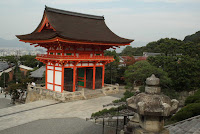
The Japanese certainly know how to pack their 130 million souls into an amazingly small space. Flying into Osaka’s Kaisan Airport, we could see low-lying river valleys filled entirely with humanity’s signature - the concrete white of countless urban buidings. Yet the lush mountains that immediately surround these valleys hold only trees, without roads or others structures. Land use patterns in this country are strikingly different than what we are familiar with. As my geography lecturer colleague and seat mate Alec Murphy said as we made our approach, “You’d never mistake that pattern for something in the U.S.
The temples themselves are specatcular! We visited Kiyomizo first and a photo of it is above. Sanju-sangendo was one of my favorite - one of the longest wooden structures in the world at almost 400 feet long. It was built in 1266 (when the Anasazi were fully occupying Mesa Verde but not yet aware of the 30 year drought that was only 10 years away). It contains 1001 wooden carved religious icons painted with gold leaf. The Golden Palace was phenomenal as well and the late afternoon light gave it a marvelous glow.
 We have dodged rain while we have been here but astute observers will see evidence everywhere that this place is no stranger to it.
We have dodged rain while we have been here but astute observers will see evidence everywhere that this place is no stranger to it.Our guides and the Japanese people have been gracious beyond all measure. They simply travel through life in a disciplined courtesy, an outgrowth no doubt of the Buddhism that pervades this society. It makes one wonder how they could have been so viscious in the 1940’s during their reign of imperialistic government. Our guide almost apologized for the “mistakes” that had been made and moved on quickly to another topic. I think that governments everywhere and at certain times are subject to pressures that make them want to exert more control over their surrounding world. I think that no governement on Earth is ever truly immune from the tendency of leaders who see imperilaistic forrays as a way to make life easier. Japan may be such an example from the past. One wonders if certain elements in our own government are an example from the present?
No comments:
Post a Comment
If your comment will not post, email me with the problem.